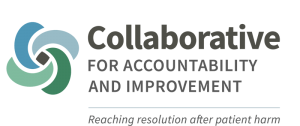Communication and Resolution Programs (CRPs) are a principled, comprehensive, and systematic approach for responding to unintended patient harm.
Despite the best intentions, healthcare does not always go as planned, which can result in harm to patients. Unintended patient harm remains a leading cause of death in the US, and can happen for many reasons, such as inherent complexity and risk, system breakdowns, communication failures, and human error. The response, or silence, from healthcare organizations can compound the pain for patients, families, and involved healthcare providers. Moreover, a lack of transparency can inhibit organizations from learning from the event and improving patient care.
CRPs offer healthcare organizations a more compassionate, patient-centered response that ultimately improves safety for patients in the future. A series of steps—taken by providers, risk managers, quality improvement leaders, healthcare leaders, and others when a patient is harmed—guide healthcare organizations in moving toward reconciliation for everyone involved. Open, empathetic communication and timely resolution for patients and providers, coupled with accountability and learning to prevent such events from recurring are at the core of the CRP process. The benefits accrue to everyone.
CRPs lead to an understanding of what went wrong, foster an environment of trust and respect with the patient or family, and improve the quality of care.
Now is the time to launch or strengthen your organization’s CRP with the PACT Collaborative!
CRPs are gaining support and traction on the national stage with the recent President’s Council of Advisors on Science and Technology (PCAST) report naming CRPs as one of a few specific initiatives to transform patient safety, and the proposed CMS Patient Safety Structural Measure including a requirement that hospitals must attest to having “a defined, evidence-based CRP reliably implemented after harm events.”
The 28 healthcare organizations that participated in the initial waves of PACT have made great strides in hardwiring and CRP processes. Past participants have all reported progress in enhancing support programs for providers, patients, and families, improving the timeliness of event reporting, strengthening event review with the patient and family narrative, developing communication coaching programs, and more!
Submit your application by June 30th and save $4,000 with the early bird price of $25,000 per organization!
Join us for an info session about the PACT Collaborative by registering here.
To learn more, download and review the PACT Collaborative Information Packet or email Melissa Parkerton, PACT Director, at mparkerton@ariadnelabs.org
Ready to apply? Download and send the completed PACT Collaborative Application to pact@ariadnelabs.org.
At its highest level, the CRP process involves:
- Reporting incidents of harm immediately
- Conducting a rapid investigation of what happened
- Sharing a full and complete explanation about the event with the patient and family
- Providing psychosocial support for the patient, family and involved providers
- Offering apologies
- Proactively offering compensation for care that was found to be below the standard of care
- Ensuring that lessons are learned to prevent recurrences
Testimonials
“I think our health care system is largely designed now to continuously improve and prompt and early communication certainly helps to do that. It reduces the worry; it reduces the concern of the patients and their family. We anticipate that this learning will continue and the program will evolve and will benefit from the experience is certainly the medical professional liability community and all those they insure”

